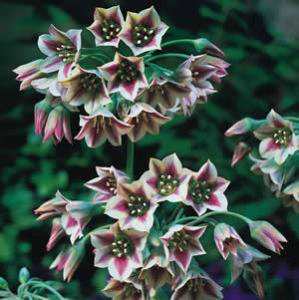Mediterranean Bells Growing Guide

What is Mediterranean Bells?
Mediterranean Bells (Nectaroscordum siculum) also called Honey Garlic, Sicilian Garlic, Allium sicilum is a perennial bulb.It is part of the Alliaceae family and is native to Southern Europe and the Balkans. In Spring the foliage appears first and is triangular, twisted and a blue/grey in colour. When crushed, the leaves have a garlic smell. Late Spring the foliage will start to fade and the flowers will emerge. The flowers are held aloft on tall straight stems. The flowers are displayed in umbels where each individual flower is a bell shape that are cream with burgundy markings flushed green at the base. The flowers are followed by decorative seed pods later in the season. Mediterranean Bells prefers a full sun position in the garden that has well draining soil.
Benefits of Growing Mediterranean Bells
Mediterranean Bells are an easy to grow bulb, requiring little water once established. These unusual coloured and pretty flowers suit beds and borders of informal designs like cottage and gravel gardens. They are perfect for cut flowers and can be used in flower arrangements. Mediterranean Bells spread naturally by self seeding.
How to Grow Mediterranean Bells
Climatic Zones
Cool, temperate, arid, semi arid.
Plant Size
Height: 90cm-1m, Width: 10cm
When To Plant Mediterranean Bells
Plant in Autumn.
Soil Preparation
Mediterranean Bells like a well drained humus rich soil. Work through a small amount of complete granular fertiliser or well broken down animal manure through soil prior to planting.
How To Plant Mediterranean Bells
Plant in full sun to part shade, 10cm apart with the bulb 8-10cm below the soil surface.
Mediterranean Bells Plant Care
Water well after planting and while in bloom. Do not water after flowering, as wet soil will rot bulbs.
As buds form, apply a complete fertiliser.
Best left undisturbed. When the clumps become overcrowded, dig and divide in Spring.
Deadhead after flowering but leave the foliage to die right back.
Fairly pest resistant as they produce sulphur, which repels insects and most pests.







